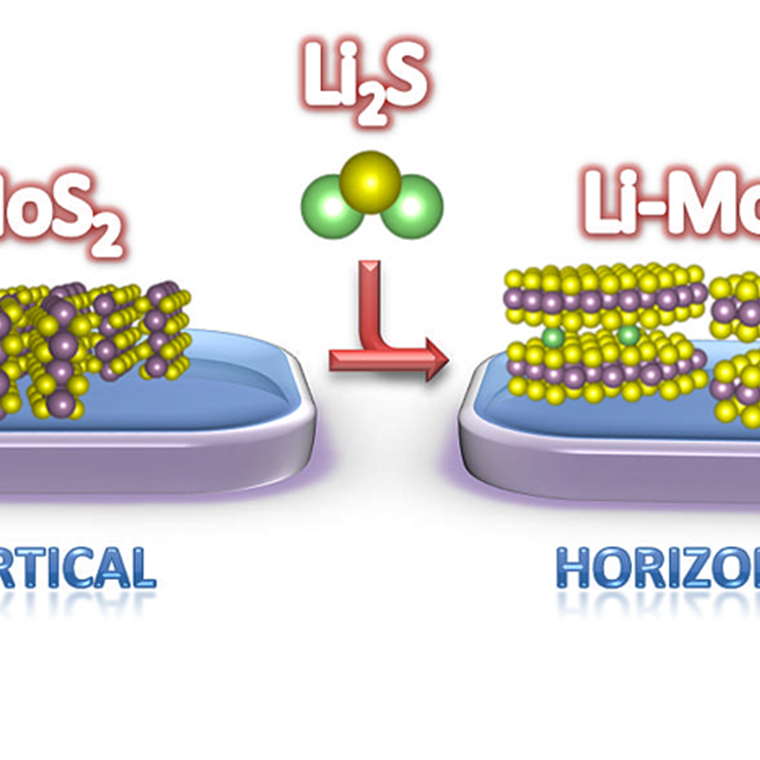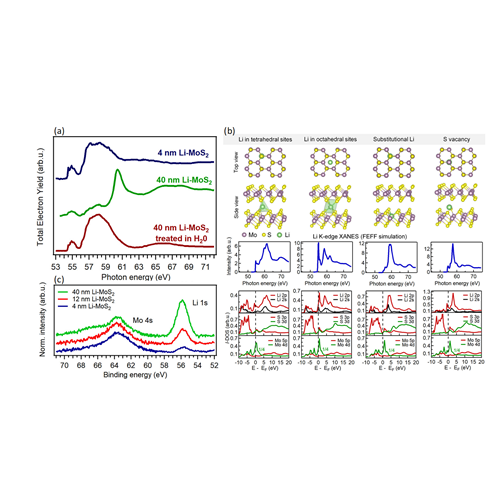Lithium induces the reorientation of few-layer MoS2 films

Molybdenum disulfide (MoS2) is a layered material that can be prepared in the form of monolayer or few-layer films. It is extensively studied due to its intriguing properties and wide range of possible applications in electronics, optoelectronics, or catalysis. The layered materials have the ability to intercalate atoms and cations into their van der Waals gaps. Intercalation is one of the ways to tune their physical, chemical, and electronic properties.
One of the metals used for MoS2 doping is lithium. Previous studies have shown enhanced catalytic performance of Li-doped MoS2 in hydrogen evolution reactions and CO2 reduction. Lithium doping has also the potential to improve Li-ion battery technology. However, the influence of lithium on the growth of MoS2 films has not been fully explored yet.
“We used a new approach to incorporate lithium into MoS2 films,” says Dr. Michaela Sojková, responsible for the films' synthesis. “We are using one-zone sulfurization of pre-deposited molybdenum layers to fabricate MoS2. To deliver lithium into the films, we replaced a part of the sulfur with lithium sulfide powder. And it worked.”
The identification of the presence of lithium in the sample is a very complex issue. There are only a few methods that allow its detection. One of these methods is synchrotron-based high energy resolution XPS with tunable photon energies in the soft x-rays range and Li- K near edge x-ray absorption (XANES). The measurements were performed at the BACH beamline of CNR at the Elettra synchrotron facility (Trieste, Italy).
“Our experimental setup allows us not only to confirm and quantify lithium in the samples and their long-term stability but thanks to the absorption near-edge structure (XANES) spectroscopy combined with calculations, we are able to confirm the position of lithium in octahedral and tetrahedral interstitial sites rather than substitutional sites,” says Dr. Federica Bondino, scientific coordinator of the BACH beamline.
“These results have benefited from the unique opportunity to access facilities with state-of-the-art methods thanks to NFFA-Europe” adds Dr. Michaela Sojková.
The structural analyses show a remarkable effect of lithium in promoting the epitaxial and horizontal growth of the films. After annealing in the presence of Li, MoS2 films tend to grow horizontally even for thicker initial molybdenum layers. The most surprising observation is the conversion of vertically aligned MoS2 to horizontally aligned films after annealing in the presence of Li. We suppose that lithium acts as a catalyst in facilitating this conversion.

(a) Li K-edge XANES spectra for Li doped 2H-MoS2 measured at the beamline BACH (b) Li K-edge XANES spectra obtained by FEFF calculations. Top: fragments of the structural models for hexagonal 2H-MoS2 with atoms in tetrahedral and octahedral interstitial sites, substitutionally doped MoS2, and with lithium near a single sulfur vacancy. Middle: simulated Li K-edge XANES spectra. Bottom: calculated orbital-projected density of states for Li, S, and Mo atoms.(c) Mo 4s and Li 1s XPS spectra from Li doped MoS2 samples. All images are from the article Lithium-induced reorientation of few-layer MoS2 films, Chem. Mater. 35 (2023) 6246-6257. Copyright © 2022 The Authors. Published by American Chemical Society. This publication is licensed under CC-BY 4.0.
In our work, we demonstrate that by lithium doping it is possible to tune the MoS2 basal plane orientation in few-layer films, which is noteworthy because vertically and horizontally oriented films exhibit distinct electronic, chemical, and optical properties. Horizontally aligned films are suitable for electronics and optoelectronics, such as ultrafast tunnel diodes or photodetectors for use in harsh environments, while vertically aligned MoS2 is a promising candidate for substituting noble-metal catalysts in electrochemical hydrogen production, conversion of CO2 to energy-rich products, water disinfection, water splitting, or solar cells. Thus, control over the MoS2 crystallographic orientation will be crucial in engineering next-generation devices incorporating MoS2 layers.
Lithium-induced reorientation of few-layer MoS2 films, Chem. Mater. 35 (2023) 6246-6257.
NFFA Europe facilities that have been used to obtain the presented results are available at the BACH beamline of CNR at the Elettra synchrotron facility (Trieste, Italy).

Dr. Michaela Sojková
Dr. Michaela Sojková is a research scientist at the Institute of Electrical Engineering, Slovak Academy of Sciences (IEE SAS). She currently focuses on the fabrication and characterization of thin films and structures made of various TMD materials. She graduated from the Faculty of Natural Sciences, Comenius University, Bratislava, Slovakia. She has been working at the IEE SAS, since 2000. In 2003-2007 she was enrolled in a double PhD study programme at the Slovak Academy of Sciences in Bratislava and the Néel Institute, Center Nationale de la Recherche Scientifique in Grenoble, France. She defended the dissertation in 2007. She was awarded a grant from the Supporting Fund of Stefan Schwarz and a postdoc position at the IEE SAS for her PhD thesis and publication activity. In 2008, she was awarded in the Competition of scientific works of young Physics (Slovak Physical Society). She has collaborated to several national and international projects. She is the author and co-author of two patent applications and more than 60 publications in peer-reviewed journals.

